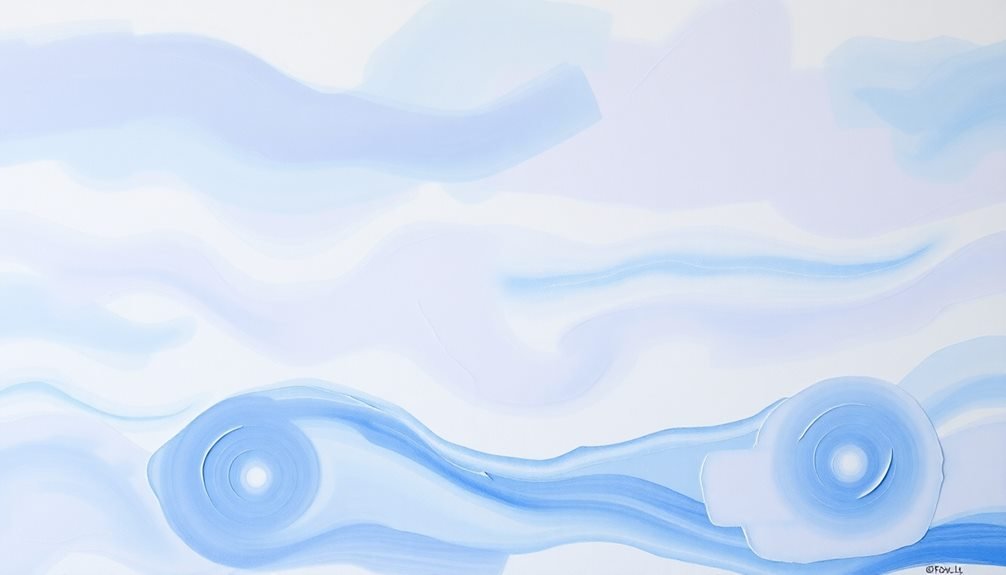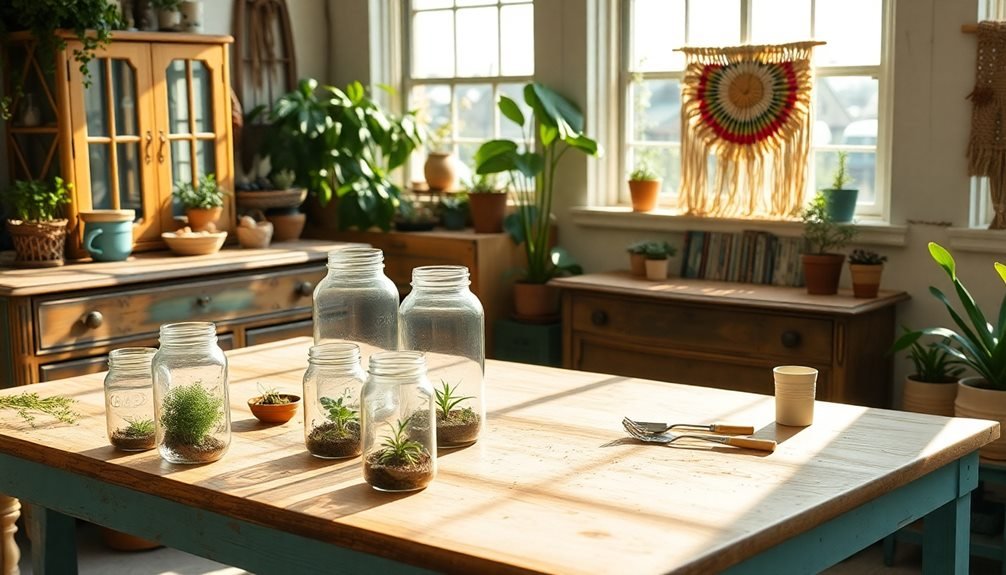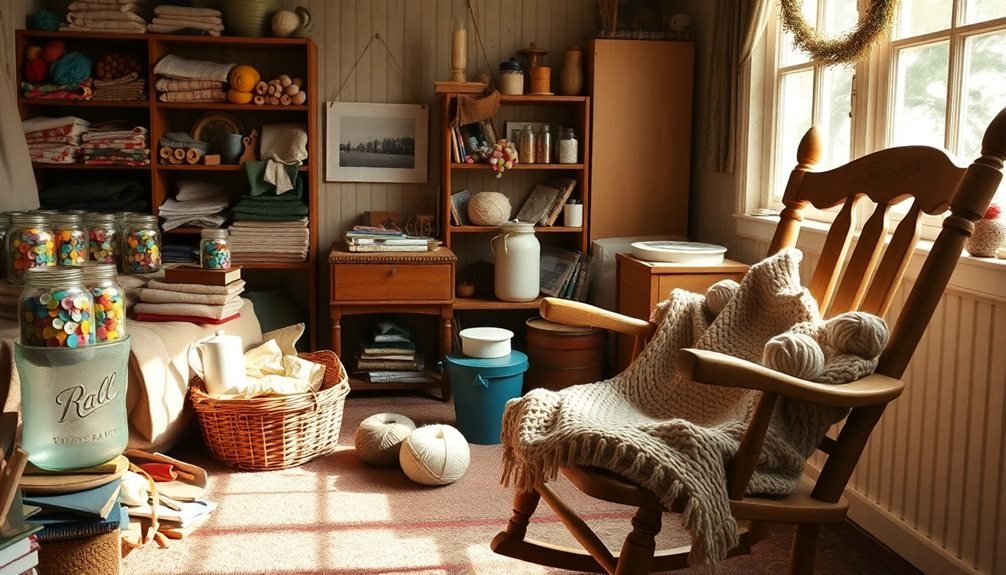Transform your painting practice into a calming ritual with these texture techniques. Start by mindfully layering thin, fluid paints – allowing each coat to dry completely. Create soothing sand textures using pumice gel and modeling paste, then enhance depth with gentle dry-brushing. Practice meditative brush strokes by synchronizing your breathing with each movement, keeping your grip relaxed. Experiment with natural sponges to develop organic patterns and cloud-like effects. Choose tranquil color combinations like cool blues, lavenders, and muted tones to establish a peaceful atmosphere. These foundational tips open the door to deeper artistic stress relief.
Layer Your Paint Mindfully

Artists know that thoughtful paint layering creates rich, tactile surfaces that invite touch. When you're building texture through layers, start with thin, fluid paint as your foundation. Let each layer dry completely before adding the next to prevent muddy colors and maintain clarity in your work.
Begin with light, translucent washes and gradually work toward thicker, more opaque applications. You'll want to vary your paint consistency – thin layers provide depth, while thicker ones create dimensional effects.
As you layer, consider using different tools: brushes for smooth strokes, palette knives for peaks and valleys, and even household items like sponges or textured fabrics for unique patterns.
Pay attention to how each layer interacts with the previous one. You can scratch through wet paint to reveal colors underneath, or use dry-brush techniques to highlight raised areas.
Don't rush the process – mindful layering requires patience and intention. Keep your movements deliberate and rhythmic, focusing on how each stroke contributes to the overall texture.
Remember that negative space between textured areas can be just as important as the built-up sections themselves.
Create Organic Sand Textures
Building on those layering principles, achieving realistic sand textures requires a specific combination of materials and techniques.
You'll need coarse pumice gel, modeling paste, and your choice of acrylic paint in sandy tones. Mix these mediums in a 2:1:1 ratio to create your base texture.
Apply this mixture using a palette knife, spreading it in random, sweeping motions across your canvas. Don't aim for perfect smoothness – real sand has natural variations.
While the mixture is still wet, sprinkle actual fine sand or glass beads onto specific areas to create depth and authenticity. Once it's partially dry, you can gently press the granules into the surface with your palette knife.
After the base layer dries completely, you'll want to dry-brush lighter tones across the raised areas to simulate how sunlight hits sand. Use small, circular motions with a stiff brush.
For added realism, create subtle shadows by glazing darker tones in the deeper crevices. You can enhance the dimensional effect by spritzing small amounts of water onto specific areas, allowing the paint to naturally settle into the textural grooves.
Meditative Brush Strokes

Many painters discover that certain brush stroke techniques can induce a calming, meditative state while creating beautiful textures. By focusing on slow, deliberate movements and maintaining a steady rhythm, you'll find yourself entering a peaceful flow state as you work.
Start with a medium-sized flat brush and load it with your chosen paint. Hold the brush at a 45-degree angle and apply gentle, even pressure as you make long, continuous strokes across your canvas. Don't rush – let each stroke flow naturally into the next. As you paint, synchronize your breathing with your movements: inhale as you lift the brush, exhale as you make your stroke.
Try practicing these mindful techniques: Create parallel lines with consistent spacing, paint gentle curves that mimic ocean waves, or make circular motions that spiral outward from a central point. You can also experiment with cross-hatching patterns, letting each layer dry before adding the next.
Remember to maintain a loose grip on your brush – tension in your hands will show in your strokes. As you develop these techniques, you'll notice both your painting skills and your ability to achieve mental calm improving simultaneously.
Natural Sponge Pattern Techniques
Natural sponge texturing opens up an entirely new dimension of peaceful painting techniques.
You'll discover that using a natural sea sponge creates organic patterns that can't be replicated with brushes alone. By gently dabbing paint onto your canvas with varying pressure, you'll produce subtle gradients and intricate textures that feel effortlessly meditative.
Start by dampening your natural sponge slightly and wringing it out thoroughly. You don't want it dripping wet, just barely moist enough to help the paint spread evenly.
Dip the sponge lightly in your chosen paint color, then test the pattern on scrap paper before applying it to your canvas.
- Try rotating your wrist in small circles while dabbing to create cloud-like effects that blend seamlessly into your background.
- Experiment with different sides of the sponge to find unique texture patterns – each natural sponge has its own distinctive surface.
- Layer multiple colors using the same spot on your sponge for depth and dimension.
Remember to clean your sponge thoroughly between colors, and always keep a separate sponge for light and dark shades to maintain the purity of your peaceful patterns.
Calming Color Combinations

Soft waves of color can transform your painting into a meditative sanctuary. You'll find that combining cool blues with gentle lavenders creates a sense of tranquility, while pale sage green paired with soft ivory evokes a natural, peaceful environment.
Choose muted tones over vibrant hues to maintain a calming atmosphere in your artwork.
For a serene coastal feeling, blend seafoam green with pale turquoise and add touches of sandy beige. You can layer these colors gradually, allowing each shade to blend softly into the next.
If you're seeking a warmer palette, pair dusty rose with warm gray and subtle cream tones – these combinations remind viewers of early morning sunlight.
When mixing your colors, maintain a 60-30-10 ratio: use your main calming color for 60% of the composition, a secondary complementary tone for 30%, and an accent color for the remaining 10%.
Don't forget to step back occasionally to assess how your colors interact. If any shade feels too bold or jarring, tone it down by mixing in a touch of its complementary color or white to achieve that perfect, soothing balance.
Frequently Asked Questions
How Long Should Each Texture Painting Session Last for Maximum Stress Relief?
You'll get the most stress relief from 20-30 minute painting sessions, though you can go longer if you're in the flow. Don't force yourself to continue when you're feeling done.
Can Texture Painting Help With Anxiety-Induced Insomnia?
Yes, you'll find texture painting can help calm your racing thoughts before bedtime. It relaxes your mind and body, making it easier to drift off naturally when you're struggling with anxiety-induced sleeplessness.
What Surfaces Besides Canvas Work Well for Therapeutic Texture Painting?
You'll find success texture painting on wood panels, cardboard, ceramic tiles, glass, and thick paper. Don't limit yourself – even fabric, rocks, and polymer clay can provide satisfying surfaces for your therapeutic creative expression.
Should Texture Painting Be Done Alone or in Group Therapy Sessions?
You'll benefit from both solo and group texture painting. When alone, you can focus on personal emotions. In groups, you'll gain social support and fresh perspectives while sharing creative experiences with others.
Are There Specific Times of Day Best Suited for Stress-Relief Painting?
You'll find painting most effective during your naturally calm periods – early morning or late evening. Paint when you're feeling anxious, but don't wait until you're exhausted. Choose times when you're alert but relaxed.
In Summary
Whether you're feeling overwhelmed or just need a creative escape, texture painting offers a therapeutic way to express yourself. You'll find that layering paints, exploring sand textures, practicing mindful brushwork, experimenting with natural sponges, and choosing calming colors can help melt away stress. Give yourself permission to get lost in these tactile techniques – there's no right or wrong way to create your textured masterpiece.





Leave a Reply